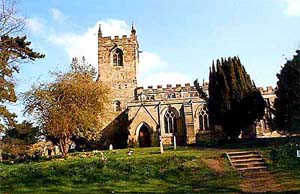Aston on Trent is a largish village situated 6 miles south east of Derby at the point where the river Trent divides the counties of Derbyshire and Staffordshire.
The village centre contains a mixture of old and new housing, several pubs and shops around an area called The Green. Close to the centre is Aston Lodge, once the residence of the Bowden family who were local lace manufacturers. The main part of the house was taken down and shipped to America, the rest was converted into flats and the grounds, into sports and playing fields.

Aston on Trent |
A few hundred yards from Aston Lodge, stands the Church of All Saints. It is interesting in that it contains every style of medieval building from Anglo Saxon to Perp. The Saxon work consists of masonry at the west end of the north aisle. There is some Saxon carving which is probably the remains of an ancient cross. The arcade and the chancel arch are Early English. The lower part of the tower is Norman, completed in the Perp period with battlements when a clerestory added to the nave.
The church possess a rare bassoon used in the church orchestra before the age of the organ. There is a monument consisting of an alabaster tomb chest with effigies of a man and wife clasping hands, she with a small dog lying at her feet, and on the side are angels bearing shields.
Aston hall once belonged to Col W. Winterbottom, who had purchased it in 1889. It was much enlarged in 1907. On his death in 1928, it was auctioned and purchased by the Nottingham Corporation for use as a psychiatric hospital, which has been its main use throughout the rest of the 20th century.
Most of the men in the village use to work either for the large estate that came with the hall, or employed in the gypsum mine, which in 1931 sold out to the Derby Brick Company. There were also tradesmen of every description living here. Now a commuter village, many of the old buildings and customs have disappeared, but Aston still retains its village atmosphere.
There are numerous prehistoric monuments on the Trent gravels here, including a Neolitic cursus, at least 5700ft long, several ring ditches and barrows, a ditched earthwork which may be a henge monument, and a number of small, square ditched enclosures, possibly Iron Age burial enclosures.
There are several inns in the village including the Malt Shovel, a 17th century building, once a farm made into a public house in 1907. Very traditional inside with oak beams, plenty of brass, and a farm theme with old small farm equipment
Other places of local interest
Weston on Trent
Shardlow